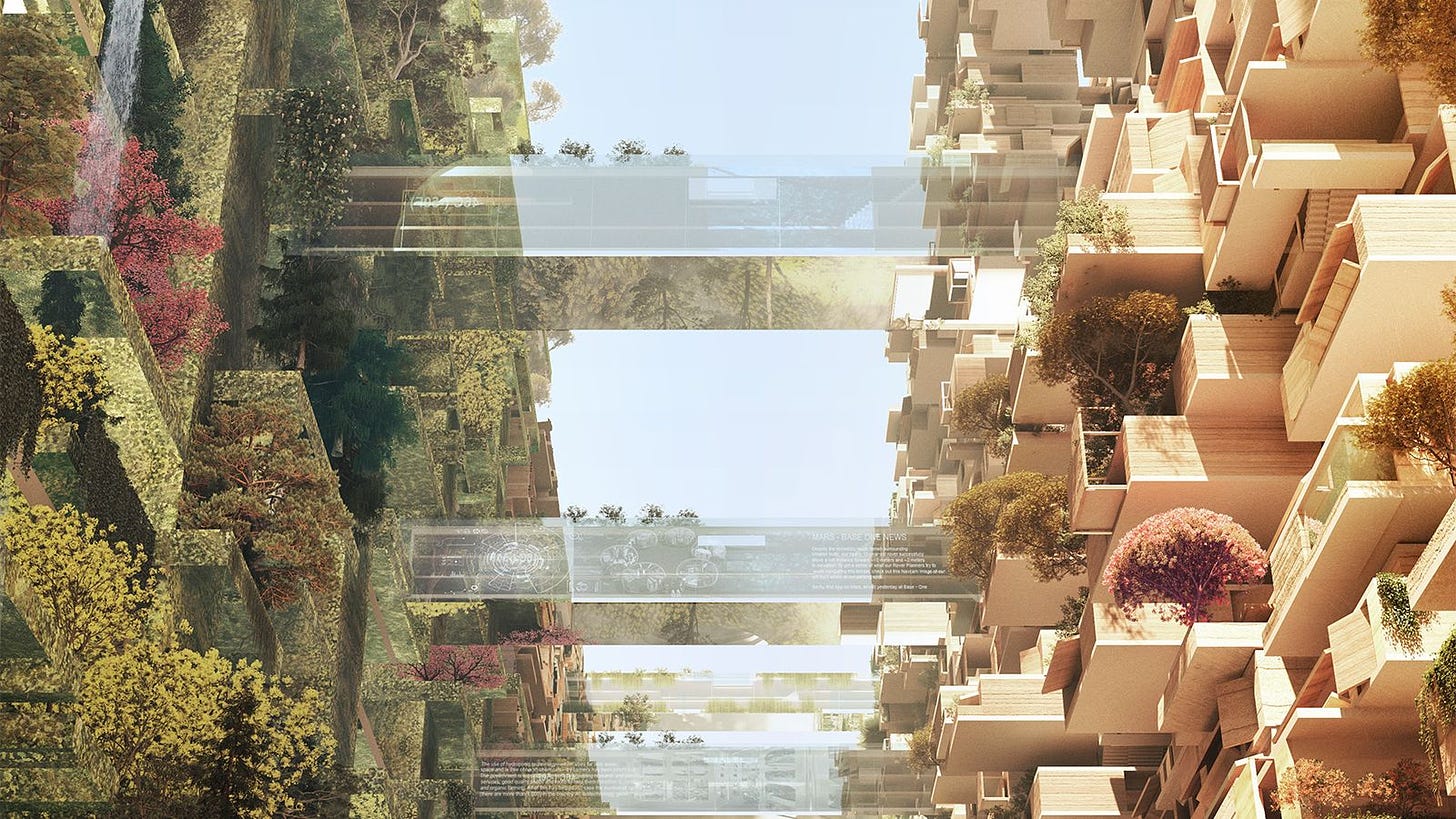
This is my latest newsletter published at Substack. Read more and subscribe here.
It takes some chutzpah, you would think, for Saudi Arabia to portray itself as a modern, forward-thinking state. Ruled by crown prince Mohammed bin Salman, the country is an authoritarian theocratic monarchy. Political parties are outlawed. No religion other than Islam can be openly practiced, and apostasy is legally punishable by death. Women have only been allowed to drive cars since 2018.
But there are other ways, outside the western liberal paradigm, for a regime to assert its progressive credentials – especially if it happens to control fifteen percent of the world’s known oil reserves. As bin Salman has shown, one effective way to harness the romance of “the future” is through design.
Witness Neom, a spectacular plan to fill the Saudi desert with hi-tech cities and resorts. One of these is already famous: “The Line,” advertised as a radically new kind of city. Nothing has been built yet, but the hype has been endless, and very successful in publicity terms. A new documentary by the Discovery Channel (or rather, a promotional film in the guise of a documentary) is just the latest instalment of it.
The Line promises to make science fiction reality. Two enormous parallel walls, taller than the Empire State building, will run for 170km through the desert. In the narrow gap between them will be a “vertical city” for nine million people. That means, in effect, the population of greater London living in a single, very long skyscraper, just three times wider than a football pitch. Everything residents need will be accessible within five minutes, it will all be powered by renewable energy, fully automated, entirely car-free, etc. etc.
“Progressive,” “futuristic” and “poetic” is how The Line is described in the new film. As bin Salman himself puts it, “we have the cash, we have the land, we have the stability,” and now “we want to create the new civilisation for tomorrow.”

The crown prince’s campaign for cultural prestige does not end there. His regime’s $650 billion Public Investment Fund is being ploughed into an array of fashionable consumer industries and green technologies, from coffee and vaping to electric cars and hydrogen-powered buses.
Bin Salman could be compared to the “Enlightened despots” of the 18th century, rulers who used their absolute power to enact progressive reforms. And just as Enlightenment philosophers were happy to act as consultants for Frederick the Great or Catherine the Great, a long list of high-profile architects and designers have flocked to bin Salman’s court. Many of them, including the erstwhile enfant terrible and Archigram founder Peter Cook, can be seen praising their client’s imagination and insight in the Discovery Channel film.
As I wrote last year, Neom has revealed a certain synergy between designers and autocrats. Unaccountable rulers like bin Salman offer vast resources and creative freedom; his architects can implement “any kind of technology… or urban design solution,” as one project manager puts it. That is an opportunity ambitious designers dream about, and in return, many are only too happy to deliver a grandiose project that glorifies their employer’s power. If all this can be presented as vital to the future of humanity, so much the better.
But I think the enthusiasm for Neom reflects something deeper than artistic vanity, something in the makeup of modern design itself. By and large, designers like to create things that are functionally efficient, rational, and optimised for specific outcomes. That applies to urban planning as much as product design, the obvious difference being that in something as big and messy as a city, there is rarely an opportunity to start from scratch. New developments have to fit into an existing landscape that has evolved chaotically over time.
With Neom, there are no such constraints. The designer’s love of functionality and order can be indulged to an enormous extent. Consider the fantasies of one planner, who wants to use her “passion as a tool for positive social change,” as reported by Bloomberg:
Imagine a sixth grader, she says. When he wakes up, his home will scan his metabolism. Because he had too much sugar the night before, the refrigerator will suggest porridge instead of the granola bar he wanted. Outside he’ll find a swim lane instead of a bus stop. Carrying a waterproof backpack, he’ll breaststroke the whole way to school. … If all goes well, she says, residents can expect an extra 10 years of ‘healthy life expectancy.’
This is human life reduced to a design problem, its smooth functioning almost indistinguishable from that of the technology that surrounds and supports it. The same tendency is apparent in the Discovery Channel film, where architects discuss The Line as though it were a new smartphone, rather than a supposed home for millions of people.

This attitude recalls some of the worst excesses of Modernism, such as the “Functional City” discourse launched by CIAM in the 1930s. Here urban life was separated out into discrete “functions,” as though society was something that could be reorganised into labelled drawers. Today’s urbanism is based on very different ideas, but there is no reason to think the results will be any less remote from people’s real needs. A city is simply too complex a thing to be re-engineered from the top down; attempting to do so is pure arrogance.
The Line resembles nothing so much as a setting for a cookie-cutter Hollywood sci-fi. When a plan is consistently sold as “futuristic,” it generally means the designers are more interested in the concept and the aesthetics than the practical reality. One can only hope they are aware that little of it will actually be built, and are just happy to go along with a petro-dictator’s publicity stunt. The other possibility – that they think they can imagine a new society into being – would be far worse.
This is my latest newsletter published at Substack. Read more and subscribe here.